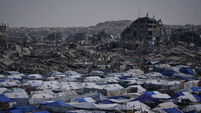Cheers and relief as lucky ones take to the air
Applause, cheers and shouts of joy rang out from New York to Asia to Paris today as planes gradually took to the skies after five days of being grounded by drifting volcanic ash.
But only limited flights were allowed to resume and British officials said London airports – a major hub for thousands of daily flights worldwide – were likely to remain closed for another day.
The Eurocontrol air traffic agency in Brussels said it expected some 55% to 60% of flights over Europe to go ahead today, a marked improvement over the last few days. By midmorning, 10,000 of Europe’s 27,500 daily flights were scheduled to go.
“The situation today is much improved,” said Brian Flynn, deputy head of operations at the Brussels-based agency. “The outlook is that bit by bit, normal flights will be resumed in coming days.”
However an international pilots group warned that ash remains a danger and meteorologists said Iceland’s still-erupting volcano is not ready to rest yet, promising more choked airspace and flight delays to come.
A Eurocontrol map showing the ash cloud today listed only the airspace between Iceland and Britain and Ireland as a no-fly zone, along with much of the Baltic Sea and surrounding area. The ash cloud also spread westward from Iceland, toward Greenland and Canada’s eastern coastline.
In many airport hubs that have been cauldrons of anxiety, anger and sleep deprivation, today marked a day of collective relief.
The boards at Paris’ Charles de Gaulle Airport announcing long-distance flights - which had been streaked with red “cancelled” signs for five days – filled up with white “on time” signs and the first commercial flight out since Thursday left for New York’s John F. Kennedy Airport.
Limited flights resumed in Scotland, and Switzerland reopened its entire airspace. Germany’s airspace – including Europe’s third busiest airport at Frankfurt – was to open starting this afternoon.
Airports in central Europe and Scandinavia have reopened, and most of southern Europe remained clear, with Spain volunteering to be an emergency hub for overseas travellers trying to get home.
Spain piled on extra buses, trains and ferries to handle an expected rush of passengers.
Ferries on the continent were so packed that the Viking line between Finland and Sweden opened up its conference rooms so passengers could sleep on the floor.
“No one’s complaining,” said ferry official Thomas von Hellens. “They are just happy to get across.”
Hopeful hitchhikers took to European roads and the technologically adept headed to Twitter, Facebook and other social media sites to find rides home across the continent.
Some flights resumed early from Asia to southern Europe, and flights began flowing to Europe from Cairo, where at least 17,000 people were stranded.
But Asian airports and airlines remained cautious, and most flights to and from Europe remained cancelled.
Australia’s Qantas cancelled its Wednesday and Thursday flights from Asia to Frankfurt and London, as well as return flights to Asia, saying the situation was too uncertain to resume flights into Europe.
It will take a while for full traffic to resume, and not everyone who wanted to could get on a flight Tuesday.
Phil Livingstone, a British university student from St Helens spent three nights sleeping on chairs at Seoul’s Incheon International Airport and living off noodles and the one meal a day the authorities provided.
“Hope is high at the minute just because it’s the only thing we’ve got,” he said.
Europe’s aviation industry – facing losses of more than a billion dollars – has sharply criticised government handling of the disruption that grounded thousands of flights to and from the continent.
But the international pilots’ federation said that a return to flight operations in Europe will be possible only if the final decisions are left to the pilots themselves, and are based on safety concerns rather than economics.
A spokesman said historical evidence of the effects of volcanic ash demonstrates that it presents a very real threat to flight safety.













